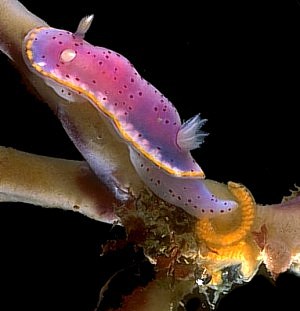
Chromodoris woodwardae
Rudman, 1983
Order: NUDIBRANCHIA
Suborder: DORIDINA
Family: Chromodorididae
DISTRIBUTION
Endemic to New South Wales, eastern Australia
PHOTO
Upper: Dark colour form on food sponge Callyspongia sp.. Note egg mass with large direct-developing eggs. Kurnell, Botany Bay, New South Wales, May 1984. Lower left: Pale colour form on pale colour form of same sponge. Locality as above. Lower right: Kurnell, Botany Bay, Sydney, New South Wales, 12m, May 1984, white form on food sponge. AM C142139. Photos: Bill Rudman.
RELATED TOPIC
Defensive colouration in sea slugs
Most chromodorids have mantle glands containing distasteful chemicals they have removed from the sponges they feed on. These glands are particularly obvious in this species as the white patches around the mantle edge. Another example of these glands can be seen in Mexichromis macropus .
There are many red and orange-spotted species of chromodorid in New South Wales and southeastern Australia. I have discussed this example of mimicry on a separate page.
References:
• Rudman, W.B. (1983a) The Chromodorididae (Opisthobranchia: Mollusca) of the Indo-West Pacific: Chromodoris splendida, C. aspersa and Hypselodoris placida colour groups. Zoological Journal of the Linnean Society 78: 105-173.
• Rudman, W.B. (1991) Purpose in Pattern: the evolution of colour in chromodorid nudibranchs. Journal of Molluscan Studies, 57, (T.E. Thompson Memorial Issue): 5-21.
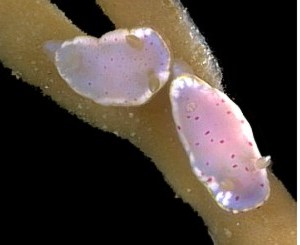
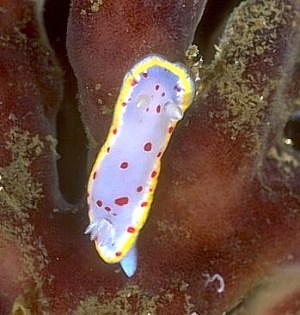
Rudman, W.B., 1998 (October 14) Chromodoris woodwardae Rudman, 1983. [In] Sea Slug Forum. Australian Museum, Sydney. Available from http://www.seaslugforum.net/find/chrowood
Related messages
Chromodoris woodwardae from Jervis Bay
March 24, 2006
From: Sue Newson
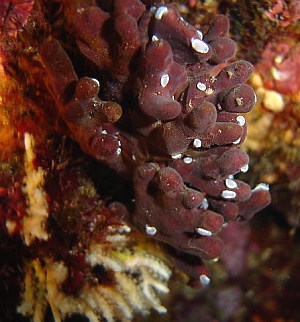
Dear Bill
Here is a photo of Chromodoris woodwardae taken at Jervis Bay, New South Wales, Australia, at a depth approx 24m on the 1 March 2003. Photo: Sue Newson.
Sue Newson
snewson@shoal.net.au
Newson, S., 2006 (Mar 24) Chromodoris woodwardae from Jervis Bay. [Message in] Sea Slug Forum. Australian Museum, Sydney. Available from http://www.seaslugforum.net/find/9732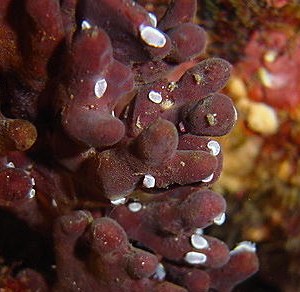
Thanks Sue,
This species can sometimes look very similar to C. thompsoni, but the clue to its identity are the callyspongiid 'finger' sponges on which it feeds. To my knowledge, no other species of Chromodoris has been reported eating sponges of this family.
Best wishes
Bill Rudman
Chromodoris woodwardae from SE Australia
October 21, 2005
From: L. & D. Atkinson
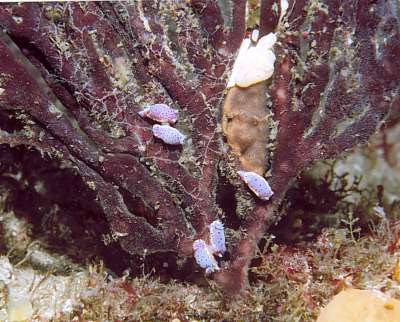
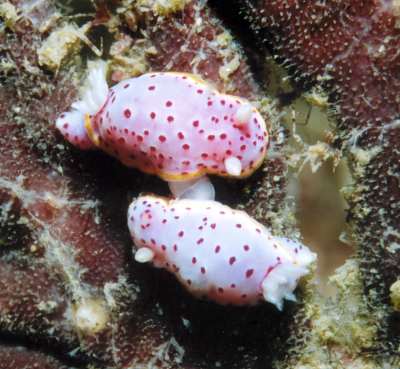
Dear Bill,
On a recent boat dive with Pro Dive Nelson Bay we found a lot of these tiny nudibranchs that look a lot like Hypselodoris bennetti but not quite. We read you paper describing Chromodoris woodwardae, Chromodoris thompsoni, Hypselodoris bennetti and some other similar looking red spotted nudibranchs. We thought these might be Chromodoris woodwardae. Many of them were mating, they were all on the same type of sponge which would appear to be their food sponge. Can you confirm their identity? There didn't seem to be many messages regarding them on the Forum.
Locality: Horseshoe Reef, N.W. Little Island, offshore from Port Stephens, New South Wales, Australia. Depth: 22 metres. Length: 10 to 15 mm. 15th October 2005. Rocky reef edged by sand and sponges. Photo: Leanne & David Atkinson
Regards,
Leanne & David Atkinson
atk@hunterlink.net.au
Atkinson, L. & D., 2005 (Oct 21) Chromodoris woodwardae from SE Australia. [Message in] Sea Slug Forum. Australian Museum, Sydney. Available from http://www.seaslugforum.net/find/15063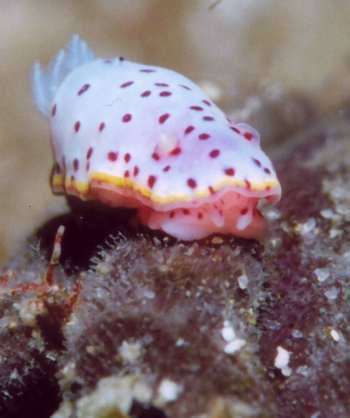
Dear Leanne & David,
Yes this is C. woodwardae. If you look carefully at the red spots you will see a faint whitish ring around each one. This is a good way iof distinguishing it from C. thompsoni where the red spots are each arranged eccentrically on a light bluish spot. It is usually found on two very similar looking 'finger' sponges of the family Callyspongiidae, [Callyspongia sp., Chalinopsilla sp.] which can't be identified from photos. As you will see from the large eggs on the Fact Sheet, this species has direct development, tiny juveniles hatching from the egg capsule as crawling young. This is why you often find them in large groups like this. They are probably all the offspring from one or a few egg masses laid on this sponge.
Best wishes,
Bill Rudman
Chromodoris woodwardae or C. thompsoni
October 24, 2003
From: Sue Newson
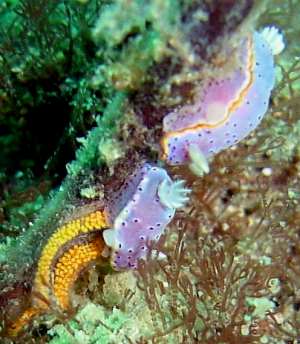
Hi Bill,
During a dive at a site called Boat Harbour Cove in Jervis Bay on Sunday 20 October 2003, I came across these nudibranchs at a depth of 14m. Due to their small size, this is the first successful image I've been able to capture.
I had previously thought they were Chromodoris thompsoni but I believe this image is of C. woodwardae. The colour variations between them has me wondering if its one species or two. I didn't wait around to note any observations other than a photo of the egg laying, due to the true purpose of this particular dive. There was another of these nudibranchs above these two on the same sponge's finger, and a few others on separate finger sponges in the same vicinity. These nudibranchs can be found all over the bay and I have always found them on the same sponge growth that we call, "the red finger sponge". I think this is the one you were referring to in a previous message as 'nondescript'. They are easy to spot as they stand out against the sponge but they are very tiny and any details are usually hard to spot with the naked eye. I've also included a photo of the sponge taken on a previous dive. If you look closely, you can just see one of the nudi's in the center, behind the pipefish.
Sue Newson
snewson@shoal.net.au
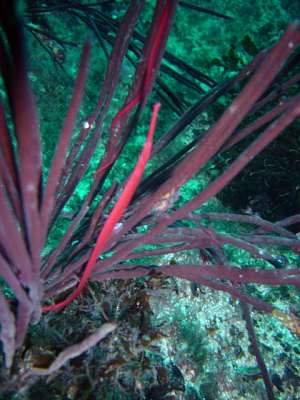
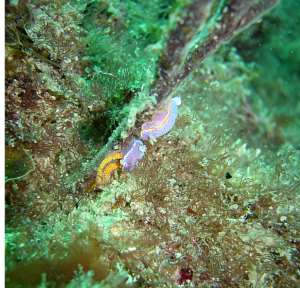
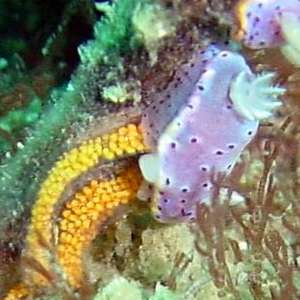
Dear Sue,
The egg mass, with large direct developing eggs, and the callyspongiid finger sponge are typical of this species. I will make a note to put more information on the Fact Sheet about this species. C. thompsoni certainly has similarities but usually there are distinct bluish spots or patches as well as reddish spots. In C. woodwardae there are sometimes paler rings around the red spots but never large bluish patches. In C. thompsoni there is usually a broad creamy mantle border with a wavy inner edge, while in C. woodwardae the pale creamy border is relatively narrow and a result of the internal mantle glands. The is usually a gold or yellow band right at the edge. I can't at this time compare the egg masses because we don't know what sort of development C. thompsoni has. We do know that it doesn't eat the finger sponges, Chalinopsilla and Callyspongia sp, which are the choice of C. woodwardae. These two are examples of a group of red-spotted species found in southeastern Australia [see Red spot Page].
Best wishes
Bill Rudman
